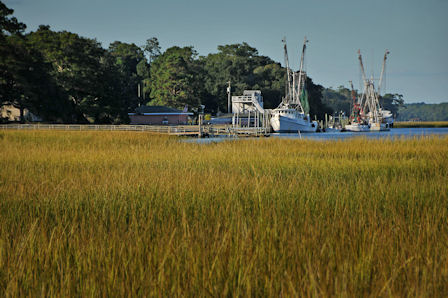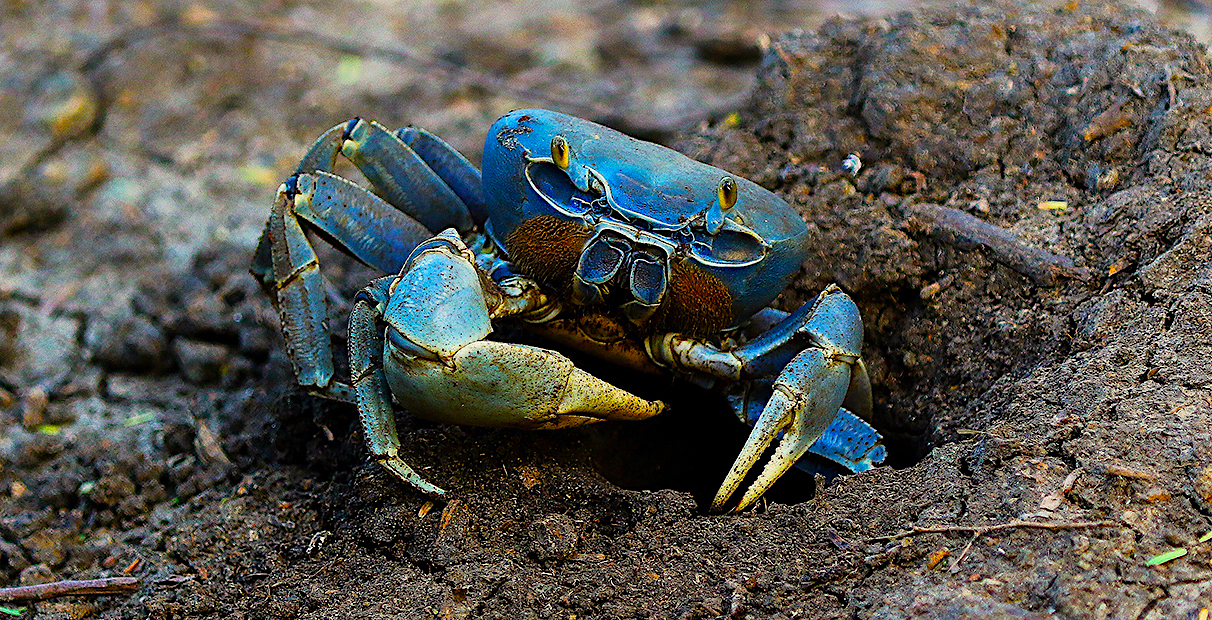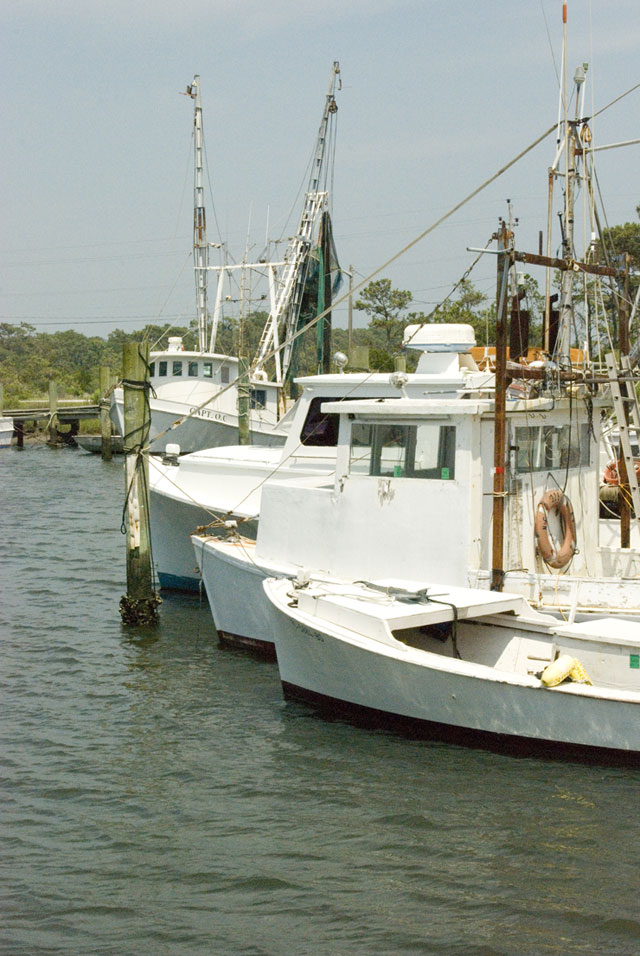Habitat Protection Plans: Homeland Security for Fisheries

High above Earth, a passing satellite blinks in recognition of North Carolina’s unique geography: A line of barrier islands protects the mainland from the ocean’s energy, channeling its flow through narrow inlets. Behind the barriers, irregular shorelines define a system of shallow sounds, bays and tidal creeks that are intricately tied to the ocean’s will. Mighty rivers appear as threads connecting mountains to piedmont to coastal plain.
Ultimately freshwater rivers empty into coastal and marine waters, creating nursery grounds for the state’s important commercial and recreational fisheries, as well as species that migrate along the coast.
But fish do not live by water alone. The water column swirls about a variety of underwater habitats that provide food and shelter necessary for spawning, breeding or growth for finfish and shellfish alike. The watery landscape includes ocean hard bottom, sand and mud bottoms, submerged aquatic vegetation (SAV), shell bottom, and freshwater and saltwater wetlands.
Healthy habitats provide the basic foundation for healthy fisheries. It’s that simple. However, rapid coastal development, degraded water quality, dredging, and the use of certain fishing gear, such as trawls, are cited as contributing to both habitat loss and fishery declines.
Though the passing satellite offers only a snapshot of the dynamic and complex coast, it provides enough detail to suggest that developing Coastal Habitat Protection Plans (CHPPs) could be a daunting task.
Nevertheless, the N.C. Department of Environment and Natural Resources (DENR) is overseeing efforts to devise strategies to protect and restore fish habitats for the long-term enhancement of coastal fisheries.
When the North Carolina General Assembly passed the 1997 Fisheries Reform Act, legislators focused on ensuring healthy stocks, the recovery of depleted stocks, and the wise use of fisheries resources through fishery management plans as well as habitat protection plans.
For starters, DENR and the Marine Fisheries Commission have been working with the N.C. Division of Marine Fisheries (DMF) to devise management plans for each significant commercial and recreational species. The process involves input from commercial fishing groups, seafood dealers, recreational anglers, scientists and interested citizens.
Attention now is focused on the process of developing habitat plans that will enlist similar public involvement, beginning with a series of public meetings this summer at coastal and inland locations.
MOVING AHEAD
It’s a job so big, that the law requires three commissions to do the heavy lifting – the Marine Fisheries Commission (MFC), the Environmental Management Commission (EMC) and the Coastal Resources Commission (CRC).
An Intercommission Review Committee (IRC), with two members from each commission, is working with scientists from related state agencies as well as university researchers to describe and classify biological systems within each habitat, determine the habitats’ value to coastal fisheries, and document threats.
The public will be asked to consider science-based remedies that the committee recommends.
Getting it all right will be critical to protecting coastal resources for the future. Committee members know that future regulatory actions by each commission must be consistent with the plans, once approved by the three commissions and adopted by the General Assembly.
After several false starts over a two-year period, the commissions regrouped last fall, hit the restart button and re-energized the process.
“There is no more important task for all three commissions than to develop Coastal Habitat Protection Plans. This is a task so important that no one commission can do it alone,” DENR Secretary William Ross told a joint meeting last fall at the N. C. Aquarium at Fort Fisher.
“Natural resources are not inexhaustible,” Ross said. “Many communities in the state see signs that they may be crossing important thresholds in the carrying capacity of natural resources.”
While growth may be a foregone conclusion at the coast, Ross sees CHPPs as proactive measures with far-reaching benefits. The key could be helping citizens and decision makers make the link between land uses and healthy fisheries.
“We must extend the conservation message from the mountains to the open waters,” Ross concluded.
To do so, says B.J. Copeland, “We will need to make our case so compelling, that citizens and legislators want to get involved.”
Copeland, former North Carolina Sea Grant director, represents the marine fisheries commission on the IRC. He adds, “We may not need new regulations, but we do need to figure what we have and how they can work to protect habitat.”
“The only way to make any of this work is to involve the people of North Carolina,” says Will Fowler, an IRC panel member from the environmental commission.
One sure way is to show how doing things differently will produce a positive economic outcome, adds Fowler, retired owner of Coast Realty and Construction on Emerald Isle.
GETTING THE WORD OUT
Mike Street agrees that getting the public involved is critical. Street, DMF coastal habitat specialist, is working with the IRC to shepherd the CHPPs development process. He and staff members are researching the science that underpins each draft chapter for IRC scrutiny.
But for all the supporting science, Street knows it will be public support that will count in the final analysis. Involving the public, he says, creates advocates.
Street and DENR are working on education and outreach efforts that include print and video materials, funded with a grant from the National Oceanic and Atmospheric Administration.
A colorful brochure presents the CHPPs mandate and describes each habitat, while a 12-page tabloid, targeted for insertion in 25,000 coastal newspapers, provides more detailed scientific information.
A professionally produced video, Fish and CHPPs, introduces viewers to fellow citizens with strong ties to the coast, including a commercial fisher, a recreational angler and an oyster farmer. Ross provides a running narration and invites viewers to get involved in the discussion.
The products – and the CHPPs speakers who are open to invitations from community organizations and local governments – are meant to foster a sense of ownership, stewardship and responsibility for coastal habitat. The public meetings will bring together citizens, scientists, state agency staff members and decision makers to address tough issues.
DENR is looking at the Chesapeake Bay Foundation as a model for community involvement here. What began there as a grassroots movement two decades ago has evolved into a multigovernment, interstate partnership that includes Maryland, Virginia, Pennsylvania and the District of Columbia; the Chesapeake Bay Commission; and federal government representatives.
For Pete Peterson, the idea of presenting ecosystem-based management plans rather than bureaucratic-driven plans may be just the approach needed.
“It is a breath of fresh air,” he says. Peterson, an IRC member from the environmental commission, is a professor of marine biology at the University of North Carolina at Chapel Hill’s Institute for Marine Science.
The three commissions working on this single issue underscores its importance to the public and politicians alike, Peterson says.
ENERGIZED ADVOCATES
Could the CHPPs process become a catalyst to unify volunteers, nonprofits and state and local governments?
Time will tell. But about a dozen N.C. Coastal Federation volunteers learn a potential carry-over lesson about shell bottom habitat one overcast Saturday in early spring.
They arrive at J&B Aquaculture Farm overlooking Stump Sound equipped with work gloves, shovels, and plenty of determination to “recycle” a mountain of about 400 bushels of oyster shells.
Some shovel. Others make quarter-bushel mesh bags. Still more volunteers take turns securing the bags with plastic twists. By mid-day, the mountain is reduced to a mere pile, and the bagged shells are neatly piled nearby.
J&B partners Jim and Bonnie Swartzenberg help transfer the bags into setting tanks built for the project. Once oyster larvae are introduced into the setting tanks, which are filled with filtered sound water, it is a matter of waiting for spat to attach to the shells. From there, the bags go into racks and are lowered onto a J&B-leased sound site. They will remain there until the spat hardens in about three weeks.
Meanwhile, oyster shell bottom habitats are being prepared to receive the next generation of oysters. One site is a federation demonstration project at Hoop Pole Creek in Atlantic Beach. Martin Posey, a Sea Grant researcher at the University of North Carolina at Wilmington, is constructing another shell bottom habitat site. Posey is conducting several oyster studies, including shell bottom design and oyster spat settlement. He also is exploring the potential of oyster restoration in certain now-closed tidal creeks.
“All habitat is under pressure,” Posey says. “But the degree varies from place to place.”
In some areas, shell bottom habitat is being destroyed by silt loading. In other places, water quality poses a threat. In some areas, both are issues. Turbid water and silting also contribute to the decline of sea grasses, he adds.
“The projects are a combination of habitat restoration and water quality and habitat improvement work,” explains Ted Wilgis, the federation’s Cape Fear Coast Keeper.
Oysters “planted” for demonstration or research are not to be harvested for consumption. Some will be placed for their filtering capacity to clean up water. Others can produce larvae for the future, he explains.
More importantly, the volunteers who have the battle scars from handling sharp oyster shells are probably “hooked.”
“They love the hands-on activity,” says Tracy Skrabal, federation senior scientist. “In one season they will gain a sense of the whole oyster ecosystem. They can see that what they do makes a difference. The educational value is unbelievable. They’ve learned about shell bottom habitat. And, learning that runoff pollution is a major cause of habitat destruction, they’ll become advocates for clean water.”
Swartzenberg points across the sound to Topsail Island. “Runoff is a major issue in these sounds, which once were prolific nursery grounds. I used to see only trees and green when I looked across at the barrier island. Now, I see only rooftops,” he says.
Neighbors on a nearby creek suffer the consequences of seasonally high nutrient levels. Too many nutrients mean too much algae and too little oxygen for living habitat to survive.
CHPPs, Swartzenberg says, are important to commercial fishing. He repeats a message he delivers in the CHPPs promotional video: “We have a shared responsibility to protect these waters,” he says. “We can have economic growth and environmental sustainability.”
So, who should get involved in the CHPPs discussion? Ask James Barry Gaskill, a member of the CHPPs outreach advisory committee who has been fishing and crabbing for a living most of his life.
He’ll tell you, “Anyone who catches fish or eats fish has a stake in the future.”
COASTAL HABITAT PROTECTION PLANS PUBLIC MEETINGS
(All meetings begin at 7 p.m.)
JULY 23: N.C. Museum of Natural Sciences, Raleigh
JULY 24: Mooresville Citizens Center, Mooresville
JULY 29: Brunswick Electric Membership Cooperative, Supply
JULY 30: Northeast Branch New Hanover County Library, Wilmington
AUG. 13: East Carteret High School, Beaufort
AUG. 19: N.C. Aquarium on Roanoke Island, Manteo
AUG. 20: Town Council Chambers, Edenton
SEPT. 9: Estuarium, Washington
SEPT. 10: Pamlico County High School, Bayboro
To learn more about getting involved in the CHPPs process, or to request copies of the brochure, send e-mail to chpps@ncmail.net, or go to www.ncfisheries.net. Copies of the video are available for community organizations. Videos can be viewed at the N.C. Estuarium in Washington and all North Carolina Aquariums, and aboard many state ferries.
This article was published in the High Season 2003 issue of Coastwatch.
For contact information and reprint requests, visit ncseagrant.ncsu.edu/coastwatch/contact/.
- Categories:


